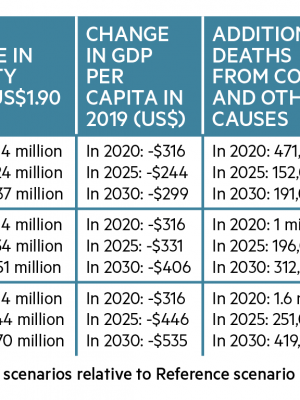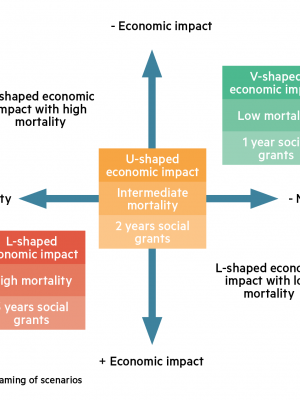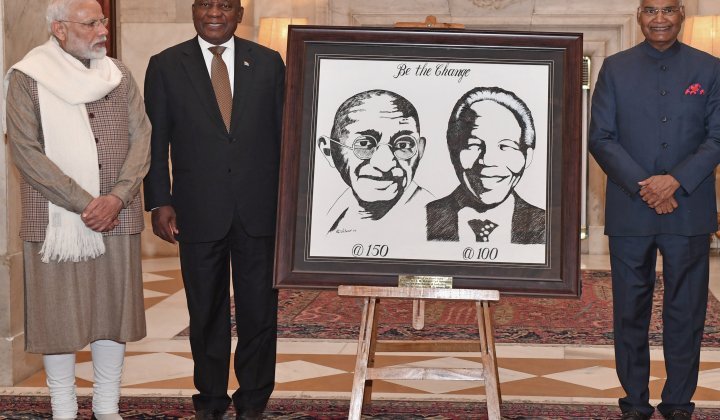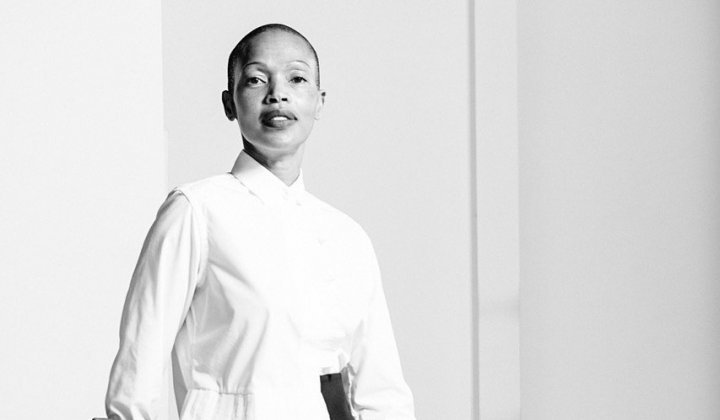Painting future scenarios is not unlike tapping into a series of parallel universes. We stand at a single point in time and use data and analysis to, essentially, foretell the future. Some permutations are rosier than others, some are bleak, and some are bright, but each starts with the current reality.
Right now, the fundamental trends which must be locked into a future outlook for the African continent are challenging, complex and have been badly burned by the Covid-19 crisis. Where does that leave Africa in the future? Understanding the trajectory of Africa’s future starts with an understanding of the structural features at play.
The starting point
Two resources give us a very clear indication of the issues Africa is dealing with. Firstly, the impact of Covid-19 in Africa scenario analysis, released in July 2020 and compiled by the Institute for Security Studies, the Frederick S. Pardee Centre for International Futures in the United States, and GIBS, and secondly, the book Africa First! Igniting A Growth Revolution.
These analyses, and the hard data which underlines the three potential scenarios outlined in the accompanying sidebar, tell us that the coronavirus effect is set to undo several years of development progress across the continent. Africa can expect to go backwards for several years – by as much as a decade – which means instability will escalate, and poverty and suffering will increase.
Whichever way you look at it, Africa is facing a reduction in its economy of between US$349 billion and US$643 billion by 2030, meaning Africa will only return to 2019 economic growth levels by 2024, at best, and 2030 at worst.
... the pandemic is not the only issue to consider when attempting to understand Africa’s future trajectory...
While the Covid-19 effect will undoubtedly have a long-term impact on individual African economies for some time to come, the pandemic is not the only issue to consider when attempting to understand Africa’s future trajectory. We need to consider issues such as food security, technological leapfrogging and regional trade. Meaningful economic transformation demands that the continent addresses key issues such as public debt, poor healthcare spending and the continent-wide dearth of basic infrastructure on essentials such as sanitation, clean water, electricity and communication.
The to-do list is long and daunting, but understanding the interplay between the following eight interrelated areas is the best place to start.
Young and dependent
Africa’s youthful population stands out against the global backdrop of ageing populations. Only in Africa is the size of the working-age population as a portion of the total population still increasing. This means that, from the middle of this century onwards, Africa is likely to experience a real demographic dividend. But, until then, the continent’s young and dependent population is likely to represent a drag on economic growth.
The number of children coming through Africa’s education systems means that keeping up with just building schools, let alone equipping them with state-of-the-art machinery and world-class teachers, puts a tremendous strain on African economies. We simply can’t educate our youthful population fast enough, nor are we getting the basics of primary education and literacy right – the prerequisites for economic growth. We only need to look at the rise of Asian giants such as South Korea to see how their early investment into their demographic transition included embedding strong educational foundations, focusing on female empowerment and family planning.
The human dividend
Africa’s climb up the human capital ladder, which is so crucial to our economic growth, requires focusing healthcare budgets on preventative measures and primary healthcare, particularly in rural and underserved areas. It is an opportunity to foster more collaboration between public and private healthcare players with, for example, the former providing national basic care and the latter contracted to provide more advanced services while sharing essential equipment and health data.
Many African countries fall far below the 15% of GDP recommended for expenditure on health, and many continue to rely heavily on donor funding to shore up underperforming healthcare sectors which are woefully incapable of dealing with outbreaks such as Covid-19, Ebola, cholera or Zika. Investing in universal healthcare in Africa, in both urban and rural areas, has never been more critical.
The urbanisation-infrastructure-industrialisation nexus
Globally, urbanisation usually goes hand-in-hand with improvements in infrastructure. Africa, which is still largely a rural population, is seeing a rise in urbanisation rates across the continent but without the requisite investment in basic infrastructure. Many African countries still have crumbling colonial systems which were found wanting during the coronavirus outbreak in terms of medical services, running water and sanitation. This highlights the need to get back to basics, to bring in the urban planners to formulate a visionary development path that covers more than free Wi-Fi and open spaces, but which taps into new modes of productivity such as urban vertical farming as well as smarter water and energy management.
Micro-solutions on this level could be powerful in several contexts, helping to reduce the vulnerabilities and insecurities inherent in the current urbanisation push, from food and energy security to industrialisation and security.
Of course, what differentiates urbanisation in Africa is that manufacturing and formal sector employment is not the magnet, but instead fleeing poverty and destitution in rural areas is the driver. This is swelling the low-quality services sector in the informal market, which is in no way productivity-enhancing. Instead, the continent is crying out for industrialisation that drives the formal economy and creates opportunities outside the precarious informal economy.
Leveraging off social grants
Until African governments can effectively create another path, social grants will remain – over the medium to long term – the most effective way to reduce inequality and reduce poverty. While data was limited on this front, we project that an additional two million people could have fallen into extreme poverty in 2020 had it not been for the additional social grants that accompanied government efforts to ameliorate the impact of Covid-19.
Africa First! deals extensively with the use of social grants and their impact, but over long-term horizons, the continued investment in social grants begins to undermine a country’s long-term pro-growth investments. Nothing is more important for Africa’s future than inclusive economic growth. Right now, there is no better mechanism or alternative than social grants for directly giving extremely poor people money to live.
Crafting a modern digital economy
While very few African countries currently have the capability of using the likes of facial recognition to ensure that social grants are only being paid to the poorest of the poor, modern technology and the effective rollout of digitisation could be used to speed up transformation, to incrementally formalise the informal sector and, over time, to reduce unemployment, inequality and poverty.
Africans leapfrogged the rest of the world with mobile connectivity (with more than 80% of young urban Africans owning their own mobile phone and using it daily) and mobile banking (with more than 100 million African mobile money subscribers, which is more than anywhere in the world). A wealth of similar innovations, if tapped into across sectors from energy to education, could accelerate transformation and growth on the continent. It could also lend weight to the African Union’s Digital Transformation Strategy, which aims to harness digital technology and innovation to generate inclusive economic growth and boost job creation.
Shaking off the isolation
When it comes to advancing technology output and use on the continent, Africa must accept that this is not a process the continent can achieve in isolation. We simply have to partner if we are to effectively mobilise capital and skills transfer with a long-term vision. There are any number of willing collaborators, from China and India to the United States and Europe, and among African nations themselves. What is important is the level of collaboration on offer and the human capital benefits.
What has also been made clear by the fall-out from the global financial crisis and the coronavirus outbreak is that Africa remains particularly vulnerable to exogenous forces. This realisation is increasingly driving the argument that Africa needs to undertake deeper introspection on how to engage on the world stage, how to sell its natural and innate potential, and how to create productive activities and industrial bases capable of lifting Africa’s people out of poverty.
There are signs of increased intra-African collaboration which are encouraging, from the African Continental Free Trade Area to the newly-created African Medical Supplies Platform. Both developments point to an Africa which is stepping up to address its own deep and structural problems, rather than consistently looking to others for help. This mindset shift will, hopefully, change the nature of how Africa engages.
Africa’s Achilles’ heel: governance
Africa must take a long and hard look at its impediments: governance, efficiency and state capacity. Only when Africa begins to address these key domestic issues will the door to greater international support and investment be unlocked. This will, in turn, result in the sort of structural transformation the continent so desperately needs.
Our research highlighted a 23% decline in remittances coming into Africa as a result of Covid-19, which will have a significant impact on the livelihoods of vulnerable people on the continent. This, together with all areas of government expenditure coming under pressure, will result in greater instability and the potential for increased armed conflict, riots and protests. As a result, for the next few years, Africa is likely to become more dependent on aid, despite the fact that donors will also be under pressure. Governance will, therefore, become an even more critical factor.
The debt factor
The potential issues around stability on the continent also extend to debt sustainability, which has been starkly highlighted by the Covid-19 pandemic. With countries like Mozambique staring down debt levels of 75% of GDP and South Africa heading to 70%, we clearly see the consequences of a fundamental lack of productivity on the African continent. While these challenges will not be addressed by a debt standstill or a debt bailout, without some relief Africa will never be able to dig itself out of its structural hole.
What is needed from a policy perspective is a package deal for Africa, something akin to the 1948 Marshall Plan in Europe, where a number of efforts (including debt relief and technology transfer) come into play from an international perspective, together with more fundamental industrial interventions. Encouragingly, we see a greater willingness from the international community to engage on these calls.
In short…
Many of the current issues on the table, and those highlighted above, are not new. All have been noted, discussed and often neglected by the current leadership of the continent. But there is nothing magical about affecting a positive African transition. Our leaders simply need to focus on the priorities that have proven, over successive decades, to lead to the steady economic growth and are the investment in agriculture, improved education, unlocking human capital potential, and ensuring that Africa’s institutions provide a foundation in which development can take place, through ensuring better governance.
But this requires that we put Africa, and her people, first.
The three scenarios
The Impact of Covid-19 in Africa scenario analysis outlines three potential scenarios that could unfold across the African continent in response to the health crisis. Each has a forecast horizon to 2030.
Using the International Futures forecasting platform, hosted at the University of Denver, the research sought to compare a pre-Covid world with one impacted by the crisis in terms of economic impact and mortality rates. The three scenarios were modelled based on low, intermediate and high economic decline and recovery, and related mortality, combined with social grants of one, two and three years, respectively. The result is a V-shaped, U-shaped or L-shaped outlook.
While no two African countries are the same, and each case must be fine-tuned to its specific complexities, what is apparent is that the impact of Covid-19 on Africa’s living standards will be notable.
The International Monetary Fund’s (IMF) pre-COVID growth forecast pointed to an African growth rate of 3.8% to 2030. Under a V-shaped recovery that would reduce to 3.1%, a U-shaped scenario would potentially yield 2.8% and a harder-hit L-shaped impact would reduce continent-wide growth to 2.4%. The rest of the world is, collectively, assumed to show a post- Covid growth rate of 1.6% to 2030, versus the IMF’s previous forecast of 2.7%.
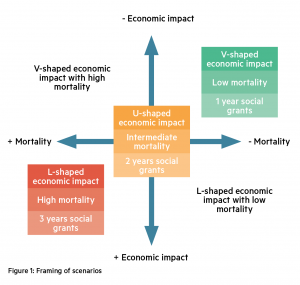
What makes the African situation more complex is that the economic stressors at play predated the healthcare crisis on the continent. This, plus the existing deficits in healthcare spending, coupled with the erosion of vaccination programmes and malaria prevention strategies, could see Covid-related deaths far outweighing those directly due to the virus.
Projections from Imperial College London indicate, at best, 344,000 additional respiratory communicable disease deaths in 2020 under a V-shaped outlook, rising to 1.45 million in 2020 for the worse-case L-shaped scenario. The latter also estimates an additional 886,000 deaths in 2021 and 518,000 in 2022.
This increase in mortality would have a marked economic impact that would push more Africans into poverty (those living on less than US$1.90 a day). Currently, about 36% (or 469 million) Africans live in extreme poverty, a figure which should have reduced to 33% or 570 million out of a total population of 1.7 billion by 2030 had Covid not hit. Now the scenarios point to the following figures: 607 million (35%) for the best-case V-shaped scenario, 621 million or 36% for the U-shaped outlook, or 640 million (37%) for the L-shaped recovery.
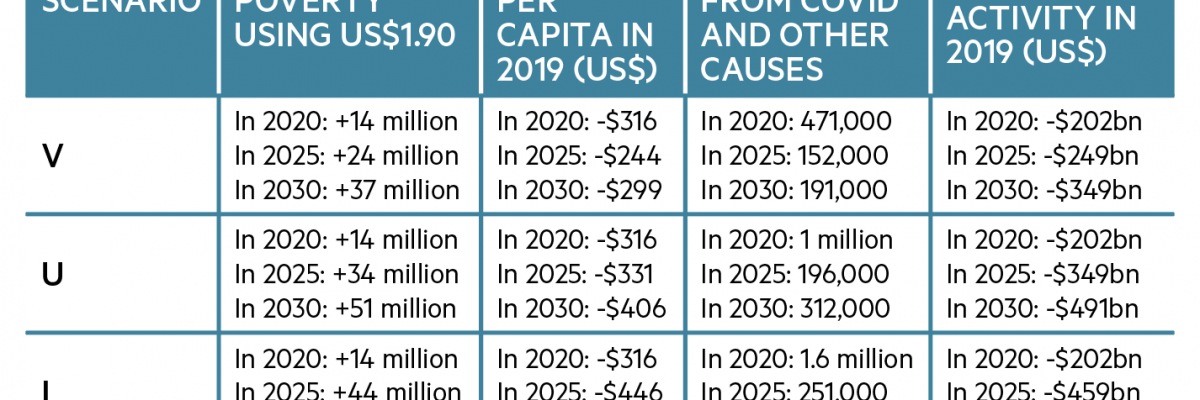
Any hope of achieving the Sustainable Development Goals target of eliminating extreme poverty by 2031 will be dashed and compounded by the fact that Africa will only recover to its 2019 average income levels in 2024, 2027 and 2030 based on the scenario outcome.
The impact on the continent will be profound.
KEY TAKEAWAYS
· Understanding the trajectory of Africa’s future starts by understanding the structural features at play.
· The coronavirus effect is set to undo several years of development progress across the continent.
· Africa can expect to go backwards for a number of years – by as much as a decade – which means instability will escalate, and poverty and suffering will increase.
· For the continent to transform it must address key issues such as debt, poor healthcare spending, the basic infrastructure, and the need to embrace innovation and technology.
· Ensuring better governance and embracing collaborating intra-African and global partnerships are vital focus areas.
We simply can’t educate our youthful population fast enough...
Many African countries still have crumbling colonial systems...
We simply have to partner if we are to effectively mobilise capital and skills transfer...



